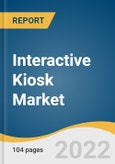The global interactive kiosk market size is expected to reach USD 52.74 million by 2030, registering a CAGR of 7.1% over the forecast period. Increasing consumer involvement in the purchase process and an extensive focus on customized service delivery by industry players are the major factors driving the adoption of interactive kiosks. The geographical expansion and service enhancement using interactive kiosks enable companies to offer convenient, swift, and hassle-free service to customers with enhanced safety and security. The North American regional market dominated the global market in 2021.
The region’s growth can be attributed to incumbents of the retail and BFSI verticals, who continue to deploy interactive kiosks as part of their efforts to enhance the consumer experience. However, the Asia Pacific regional market is expected to register the fastest CAGR over the forecast period as the retail, hospitality, BFSI, and healthcare verticals continue to grow. Incumbents of these industries continue to emphasize customer engagement. Based on end uses, the market has been further segmented into BFSI, retail, food & beverage, healthcare, government, travel & tourism, and others. Manufacturers have developed multiple self-service kiosks solutions for segments, such as travel & tourism, and healthcare.
These interactive kiosks enable customers to carry out self-check-in/-out in hotels, carry out self-baggage check-in, book tickets, view product information, book appointments, and so on. Stringent regulatory and legal standards, such as the General Data Protection Regulation (EU GDPR), Americans with Disabilities Act (ADA), and UL standards, are the significant challenges impacting the broader adoption of interactive self-service kiosks. GDPR compliance focuses on protecting customers’ private data to enhance safety and prevent unauthorized access to private information. The ADA standards provide access specifications to any public access system for disabled individuals. However, the threat of cyber-attacks and high costs of installation, maintenance, &support may hinder the market growth.
The region’s growth can be attributed to incumbents of the retail and BFSI verticals, who continue to deploy interactive kiosks as part of their efforts to enhance the consumer experience. However, the Asia Pacific regional market is expected to register the fastest CAGR over the forecast period as the retail, hospitality, BFSI, and healthcare verticals continue to grow. Incumbents of these industries continue to emphasize customer engagement. Based on end uses, the market has been further segmented into BFSI, retail, food & beverage, healthcare, government, travel & tourism, and others. Manufacturers have developed multiple self-service kiosks solutions for segments, such as travel & tourism, and healthcare.
These interactive kiosks enable customers to carry out self-check-in/-out in hotels, carry out self-baggage check-in, book tickets, view product information, book appointments, and so on. Stringent regulatory and legal standards, such as the General Data Protection Regulation (EU GDPR), Americans with Disabilities Act (ADA), and UL standards, are the significant challenges impacting the broader adoption of interactive self-service kiosks. GDPR compliance focuses on protecting customers’ private data to enhance safety and prevent unauthorized access to private information. The ADA standards provide access specifications to any public access system for disabled individuals. However, the threat of cyber-attacks and high costs of installation, maintenance, &support may hinder the market growth.
Interactive Kiosk Market Report Highlights
- The market is technology-driven and rapidly evolving market due to continuous advancements in communication and payment technologies.
- This, in turn, has widened the scope of application in various industries, such as retail, banking, hospitality, entertainment, and government.
- The declining prices of hardware and improved transaction safety features have led to increased product adoption by various businesses.
- Mandatory government regulations regarding data privacy/protection and regulatory standards, such as ADA and UL, will have a major impact on the adoption of interactive kiosks as a service delivery tool.
- Asia Pacific regional market is expected to witness the fastest CAGR over the forecast period.
Table of Contents
Chapter 1 Methodology and Scope
Chapter 2 Executive Summary
Chapter 3 Interactive Kiosk Industry Outlook
Chapter 4 Interactive Kiosk Market: Cost Analysis
Chapter 5 Interactive Kiosk Component Outlook
Chapter 6 Interactive Kiosk Type Outlook
Chapter 7 Interactive Kiosk End Use Outlook
Chapter 8 Interactive Kiosk Regional Outlook
Chapter 9 Competitive Analysis
Chapter 10 Competitive Landscape
List of Tables
List of Figures
Companies Mentioned
- Advanced Kiosks
- Diebold Nixdorf, Incorporated
- Embross
- IER
- Kiosk Information Systems
- Meridian Kiosks
- NCR Corporation
- REDYREF
- Slabb Inc.
- ZEBRA Technologies Corporation
- Source Technologies
Methodology

LOADING...
Table Information
| Report Attribute | Details |
|---|---|
| No. of Pages | 104 |
| Published | February 2022 |
| Forecast Period | 2022 - 2030 |
| Estimated Market Value ( USD | $ 30.41 Billion |
| Forecasted Market Value ( USD | $ 52.74 Million |
| Compound Annual Growth Rate | 7.1% |
| Regions Covered | Global |
| No. of Companies Mentioned | 11 |









